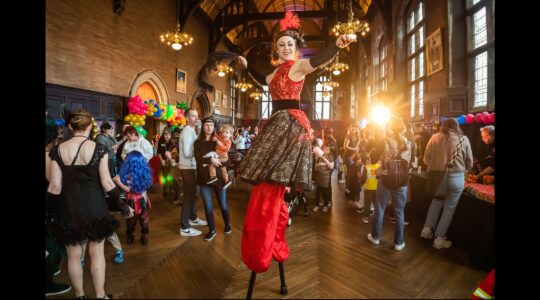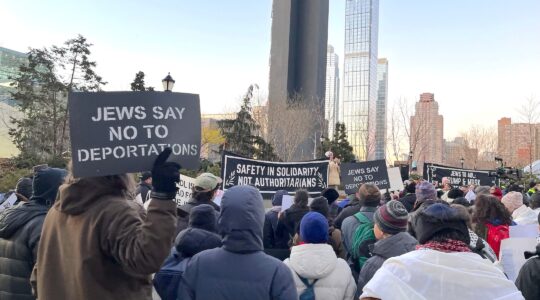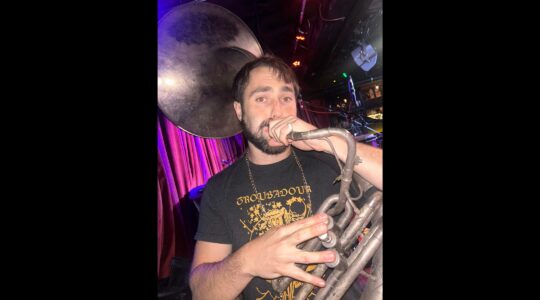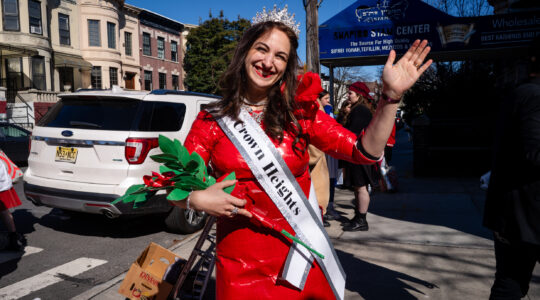Berlin: Construction cranes seem to hover everywhere in the skyline of this capital city. Since the Berlin Wall fell in November 1989, startling new buildings designed by some of the world’s most acclaimed architects (Frank Gehry, Rienzo Piano and Richard Rogers) have gone up, particularly in the formerly deserted zone that bordered the wall.
But construction has yet to begin on what is likely to be the most meaningful new addition to the Berlin landscape.
The Memorial to the Murdered Jews of Europe represents Germany’s first central memorial dedicated specifically to Jews killed in the Holocaust. Work on the memorial, a "waving field" of plinths designed by the New York-based architect Peter Eisenman, was set to begin early next month. But construction bids came in higher than anticipated, postponing the start of work at the nearly five-acre site near the Brandenburg Gate until the spring of 2003.
The delay promises to keep the project in the media spotlight, as it has been since the idea first publicly emerged in the late 1980s. The highly sensitive memorial project has prompted vociferous political and artistic debates.
Much of the difficulty stems from German reality today.
"In voiding itself of Jews, Germany had forever voided itself of the capacity for a normal, healthy response to Jews and their ideas," the Holocaust memorial expert James Young writes in an essay detailing the memorial’s history in "At Memory’s Edge" (Yale 2000).
Young, an American, was the only foreigner and the only Jew on the commission ultimately charged with finding a suitable memorial design.
Even after Eisenman’s design was selected in 1997, it was revised several times. In its final incarnation, the plan consists of a field of 2,700 uniformly cast concrete stelae set into the ground at varying heights and irregular angles. The plan also includes a subterranean, multimedia information center called "the Ort" (German for "place").
The $27 million (27.6 million Euros) project is now set for completion in 2004.
Ongoing public attention makes for frequent controversy, says Sybille Quack, director of the 2-year-old foundation overseeing the government-funded project. For example, she says that advocates for the disabled recently filed a lawsuit against the foundation because they believed the design was not adequately wheelchair accessible.
But, Quack insists, "thinking, debating and fighting about art, asking many questions" is both "necessary and good," fostering a lively interest in the memorial. Debate, she says, is essential to the memorial process.
The idea for a memorial to the murdered Jews of Europe originally was proposed in 1988 by Lea Rosh, a television personality, and Eberhardt Jackel, a World War II historian.
After the Berlin Wall fell, then-Chancellor Helmut Kohl sought to satisfy the need for a war victims’ memorial. But the monument that was dedicated in 1994 for this purpose met with significant objections. The statue by the Expressionist sculptor Kathe Kollwitz, titled "Pieta," depicts the typically Christian image of a mother huddled over the body of her dead son. Moreover, the monument, at a former Prussian royal guardhouse called "Neue Wache," failed to distinguish between the victims and the perpetrators of the Holocaust.
The following year, the government set aside the land for a new memorial, on prime real estate at the heart of the reunified city. An international design competition brought in 528 designs from around the world.
The winning design by the Berlin-based artist Christine Jackob-Marks was announced in 1995: a 300-foot square-shaped concrete slab engraved with the 4.5 million names of Jewish Holocaust victims recovered by Yad Vashem in Jerusalem. Critics, including Kohl, assailed the design as too big and undignified. Others found the design inappropriate because, as Young notes, it incorporated 18 boulders from Masada, a site in Israel associated with Jewish self-sacrifice.
After two years of vigorous public discussion, the competition’s apparent failure fomented growing dissatisfaction. With Germany’s federal government poised to move to Berlin from Bonn, creating a national memorial to Europe’s murdered German Jews gained renewed urgency.
A five-member commission was formed and asked to make an authoritative recommendation on the memorial’s design. The group included Young and the directors of two German museums, an art historian and a critic of postwar architecture.
According to Young, the commission posed essential questions about the memorial: What are the national reasons for remembering? Who is being remembered and by whom? Should the memorial be contemplative or pedagogical?
These questions and others, Young writes, "must be made part of the memorial process … so let them be asked by the artists [as part of ] their designs, even if they cannot be answered."
The commission opened a new competition in 1997, inviting the nine finalists from 1995 and a dozen artists and architects to submit designs. In November, the commission announced the winner: a "waving field of stones" designed by Eisenman and the sculptor Richard Serra.
Eisenman is known for taking familiar, comforting forms (for example, a house) and ridding them of any nostalgic associations. Among his best-known commissions is the Wexner Center at Ohio State University.
In the Memorial to the Murdered Jews of Europe, Eisenman arranges pillars in a grid pattern but positions them on gently and irregularly sloping ground. Visitors will move through the rows of pillars on seemingly unsteady ground.
The Berlin memorial is "one of the most important projects I’ll ever do," the architect told The Jewish Week. Eisenman says he did not set out to convey the experience of the Holocaust in this work. "You cannot portray that horror or represent it," he says.
He can, however, produce a feeling of danger and discomfort. "It won’t be a walk in the park," Eisenman says of the Berlin project.
At Kohl’s request, Eisenman early on agreed to make several changes to his design, for example, reducing the number of stelae from about 4,000 to 2,700. (Serra rejected the changes and left the project.)
Another revision followed the German elections in 1998, which ousted Kohl. The incoming minister of culture under Gerhard Schroeder wanted a more pedagogical memorial; eventually the minister and the architect arrived at a compromise plan that would include an interpretive center in the memorial site.
Still, the Bundestag had yet to vote on the design, and a new controversy flared when Eisenman’s proposed designs for the information center were unveiled and taken as a fait accompli, Young writes. A hearing on the memorial was held, with remarks by Rosh, Young and the culture minister, Michael Naumann, as well as the memorial’s leading opponents.
Finally, in June 1999, the Bundestag voted on and approved Eisenman’s design. The official groundbreaking was held Jan. 28, 2001: two years after the date originally planned, to coincide with Germany’s Holocaust Remembrance Day.
Today, the informational center is being developed in consultation with distinguished historians and representatives of the Jewish community. Quack says her foundation is cooperating in the effort with Yad Vashem, which provided the individual histories.
When the memorial is finished, Berlin will have a Holocaust memorial designed by an American Jewish architect, Eisenman, and created with considerable input from an American Jewish expert, Young. But Young says it’s important that the memorial be viewed as a German initiative undertaken in the name of the German government.
"It’s by Germans about the victims of Germany," he says.
Young says Eisenman’s role is especially significant because it reflects an international approach to the memorial and safeguards against provincialism. At the same time, he warns that the choice of a foreigner might allow Germans to shrug off responsibility for their own memorial by seeing it as "Americans making things for Germans to remember Jews by."
The New York Jewish Week brings you the stories behind the headlines, keeping you connected to Jewish life in New York. Help sustain the reporting you trust by donating today.




